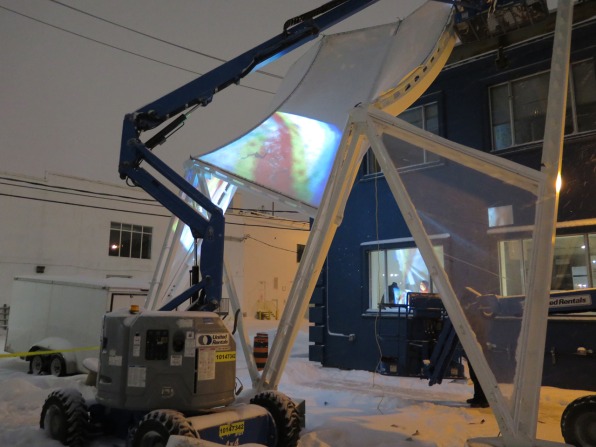How To Build A Lab In Minecraft
Before central heating and air-conditioning, cities looked very different–awnings and protective elements that would brand the weather, both hot or cold, more than endurable for people as they moved effectually outdoors. But as AC and oestrus accept become ubiquitous, many of these external structures have disappeared from cityscapes.
At present, the Alphabet company Sidewalk Labs is experimenting with a radically new kind of awning in Toronto, where the company is building its start smart city development. Called a "edifice raincoat," the flexible awning'southward purpose is to increase people'due south comfort when they're outdoors by sheltering them from air current and pelting. Ultimately, Sidewalk Labs hopes that the raincoat could get people to spend more time outside, fifty-fifty if it'due south cold. Ultimately, the design could lower the free energy needed to heat and cool the structures in the long term.
The raincoat was designed by Toronto-based firms RWDI, which specializes in climate engineering, and Partisans, which focuses on experimental, tech-driven compages. The grouping debuted the tensile structure, which was derived specifically from RWDI's analysis of how to mitigate wind and precipitation, over the weekend at Sidewalk'due south Toronto role, 307. The raincoat, which looks virtually similar a futuristic tent fabricated from a thin plastic membrane that's pitched against the side of a edifice, will stay there for an entire twelvemonth as the pattern team tests its performance to see if information technology measures upwards to their estimations.
According to Jesse Shapins, Sidewalk's Director of Public Realm & 307, Toronto's streets are merely comfy for about 30% of the year–and that's no surprise, given that the Canadian city's winters are long and brutally common cold. According to RWDI'southward analysis, the raincoat could potentially double the amount of fourth dimension people could comfortably spend outside in the neighborhood. That assay is based on the Universal Thermal Comfort Index, which takes into business relationship environmental factors like air current, atmospheric precipitation, humidity, and temperature, as well as other factors like what people clothing.
The goal is to make people more comfortable equally they participate in borough life on the streets starting earlier in the spring and afterward into the fall, extending what Shapins chosen "patio season" with more than farmers' markets, patio seating, and more public events outdoors. Shapins says that programming volition be an important element of this goal, since the prospect of less exposure to the elements solitary won't necessarily go people outside–but a farmers' market place would. That's why the prototype of the raincoat at Sidewalk Labs's Toronto part volition too have a public art component, with swirling projections that reply to their surround.

To design the raincoat, Partisans came up with a serial of architectural concepts, which the climate engineers at RWDI then ran through figurer simulations that modeled an boilerplate bound or autumn twenty-four hour period in Toronto and analyzed how the raincoat design would manage wind and sun. Through this process, the architects tweaked their design to maximize the functioning guidelines that Sidewalk was looking for.
For Shapins, there's an even greater purpose here: to design buildings that are more than in tune with the environment.
"Nosotros're looking to create this expanded, big gradient from indoors to outdoors that is much less nigh fixed moments where now I'm outside and now I'm within, just is more of a spectrum of comfort," he says. That could hateful that the footing floors of buildings are more open to the outdoors–which would make them closer in temperature to the weather exterior. If Sidewalk can successfully modify people'due south expectations effectually indoor temperature on the ground flooring, the visitor could employ less free energy for heating and cooling–contributing to its plan to exist carbon neutral.
Shapins acknowledges that calculation a structure like this to the outside of a meaning portion of buildings would be far more expensive than a typical facade. Merely he besides points out that cities like Toronto have extensive underground systems and drinking glass facades connecting buildings that cost significantly more than the prototype Sidewalk is developing.
Ultimately, this is about what Shapins calls "community vibrancy"–a somewhat ineffable quality that you sense when y'all walk down the street of a thriving neighborhood. People are out and near, shopping, running errands, and walking their dogs. The streets seem to thrum with energy. While about cities come past this vibrancy organically, Sidewalk Labs is embarking on a project to engineer it.
How To Build A Lab In Minecraft,
Source: https://www.fastcompany.com/90314333/sidewalk-labs-is-developing-a-raincoat-for-buildings
Posted by: edelenricated.blogspot.com


0 Response to "How To Build A Lab In Minecraft"
Post a Comment